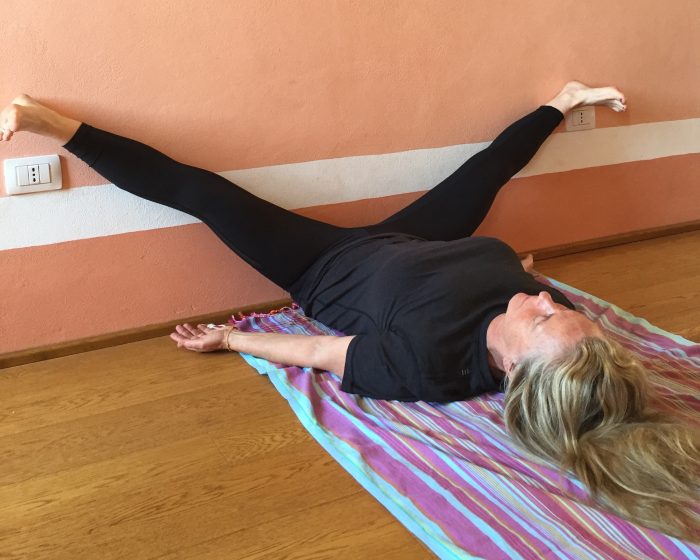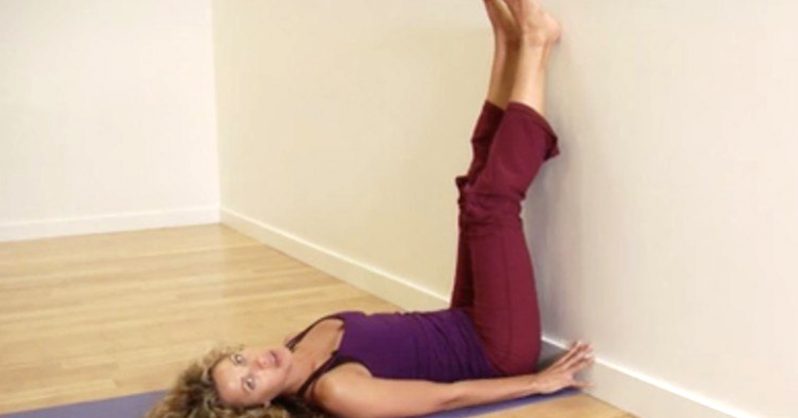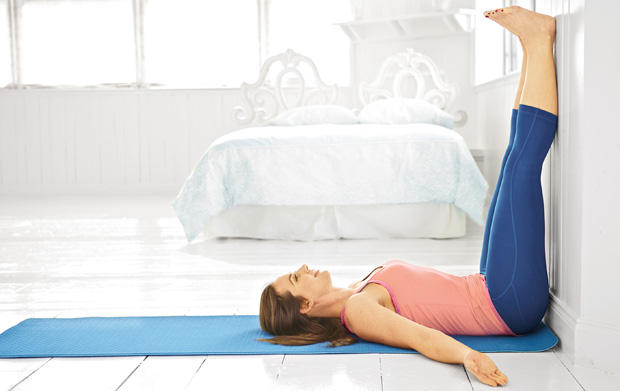Some people can perform and learn new yoga positions with ease, and make it look effortless. Others, however, can find it quite intimidating or difficult to get started.
RELATED STORY:
If you belong to the second group of people but still want to reap the mental and physical benefits of yoga, there are simple positions that can ease your way into the practise without being overly time consuming or difficult to perform. One of these is Viparita Karani. Get started with this eco-friendly yoga mat.
What is Viparita Karani?
Viparita karani, also known as Inverted Lake Pose or Legs up the Wall pose, is one of the simplest yoga poses that almost anyone can perform in the comfort of their own home. It has become popular with runners, athletes, dancers, and stressed-out office workers alike for its ability to relieve pain and tightness, reduce anxiety, and bring about complete mind and body relaxation at the end of a long, stressful day or before an important event.
Viparita Karani Variations
There are several ways to perform this yoga pose, and whichever you choose will depend on your own abilities. Do not worry if you need to start with the simplest version, yoga is a practise, meaning that regularly performing the pose will allow you to gradually work your way deeper into every pose and eventually into more complicated variations of them.
Legs Straight up the Wall Version
Viparita karani in its simplest form involves lying on your back with your bum right up against the wall, or as close to the wall as you can comfortably get it, with your legs extending straight up the wall hip distance apart. You may wish to prop your bum up on a pillow, especially if you are pregnant.The soles of your feet should be facing upward toward the ceiling, not pointing your toes. You can have your arms lying beside you for balance or folded across your chest. Again, the amount of stiffness in your hips and hamstrings will determine just how close to the wall your legs are and how straight they run up it. Ideally, they will be touching the wall all the way up and be completely straight, but it may take a while for you to get there.
RELATED STORY:
Legs in a Wide “V” Version


For a deeper stretch in the groin, you can do the exact same position except instead of keeping your feet hip distance apart, you can spread your legs into a wider V formation. This will increase the stretch in your groin area while still being quite gentle.
Soles Together Version

 Finally, for the deepest groin stretch you can get from this position, turn your knees outward and bring the soles of your feet together, with your legs still fully pressed against the wall. You can then bring your connected feet down close to your pelvic region. This can be quite an intense stretch for your groin muscles, so move slowly breathe through it, remembering that it should never hurt or feel like you have to fight with yourself to get into the pose. If that is the case, you are not ready for this variation. (1, 2)
Finally, for the deepest groin stretch you can get from this position, turn your knees outward and bring the soles of your feet together, with your legs still fully pressed against the wall. You can then bring your connected feet down close to your pelvic region. This can be quite an intense stretch for your groin muscles, so move slowly breathe through it, remembering that it should never hurt or feel like you have to fight with yourself to get into the pose. If that is the case, you are not ready for this variation. (1, 2)
Advanced Version
This version is more advanced than the first and requires more balance and mobility. If you find the first version challenging enough, stay there. If you think you are ready for more, follow the video below for detailed instruction. If at any point in the transition from the first variation to this one it feels uncomfortable or painful, stop and go back to one which did not cause discomfort.
Benefits of Viparita Karani
There are many reasons why you should practice Viparita Karani regularly, even if it’s the only pose you do at home.
1. Increases Blood Flow and Decreases Inflammation
Viparita Karani helps to increase blood flow and circulation throughout the body, especially after a day at work where you may have been sitting or standing for long periods of time, allowing blood to pool. By performing this pose, you help to get the blood that may have pooled in your feet, ankles, and legs to circulate throughout the rest of your body, decreasing the swelling that many of us experience our lower legs at the end of each day. This is also very beneficial for pregnant women who often experience swelling in the calves, ankles, and feet.
2. Improves Hamstring Mobility and Reduces Lower Back Pain
This pose naturally and gently stretches out your hamstrings, which often become shortened when sitting at a desk all day, leading to lower back pain. By performing Viparita Karani, you slowly elongate the hamstrings and relieve the pressure on your lower back that has been building throughout the day.
3. Reduces Stress and Stimulates Relaxation
As Viparita Karani reduces pain and increases blood flow, it also relaxes you. This stimulation of the parasympathetic nervous system allows your body to transition from the “flight or fight mode” that it is often in all day from the stresses of work and family life into a more relaxed, calm state. This will not only also allow you to decrease inflammation and reduce chronic pain and tension, but it will also allow you to get a better night’s sleep.
RELATED STORY:
Who Shouldn’t Perform Viparita Karani
Though Viparita Karani is a relatively gentle pose, it still is not for everyone. Those with serious back and neck problems should avoid this pose unless under the guidance and with the help of their physiotherapist or certified instructor. If any pain or discomfort is felt at all, they should be removed from the pose as quickly as possible.
This pose is an inversion, so those with serious eye conditions such as glaucoma should also not perform this pose. It should also be avoided during menstruation.
The Bottom Line
Viparita Karani is a fantastic pose to do at the end of each day, before an important athletic event, and after a hard workout or major stressor to relieve stress, increase blood flow, reduce pain, and relax your mind and body. It is a simple pose that nearly everyone can perform, however always talk to your doctor or physiotherapist before trying this pose if you have any neck, back, hamstring, or other physical issues to avoid further injuring yourself.





 ( Photograph by Hilmar Hilmar )
( Photograph by Hilmar Hilmar )







